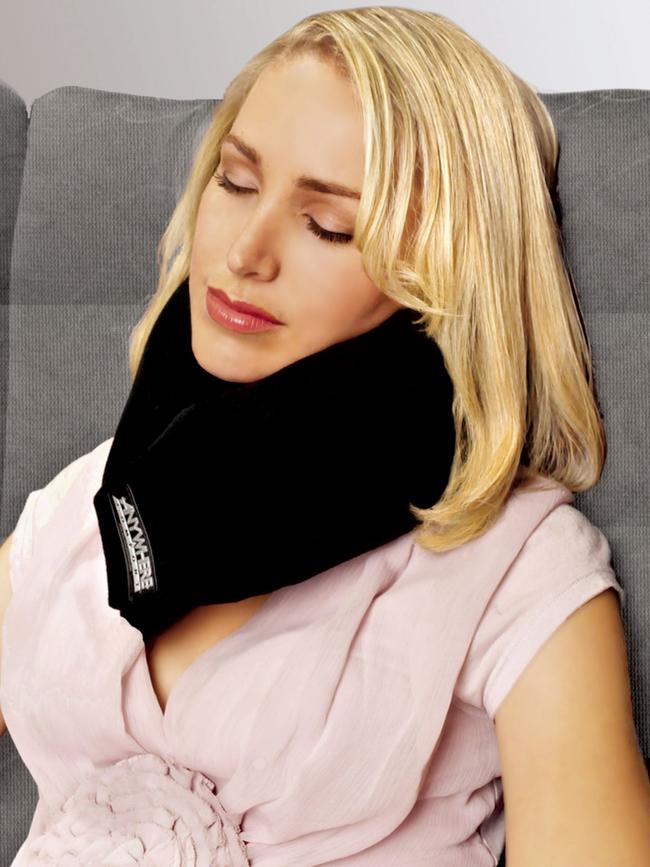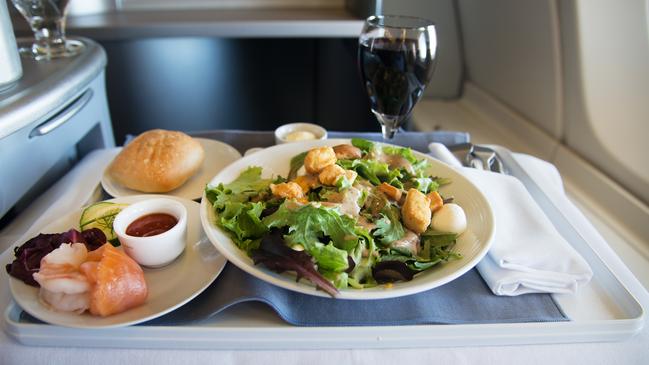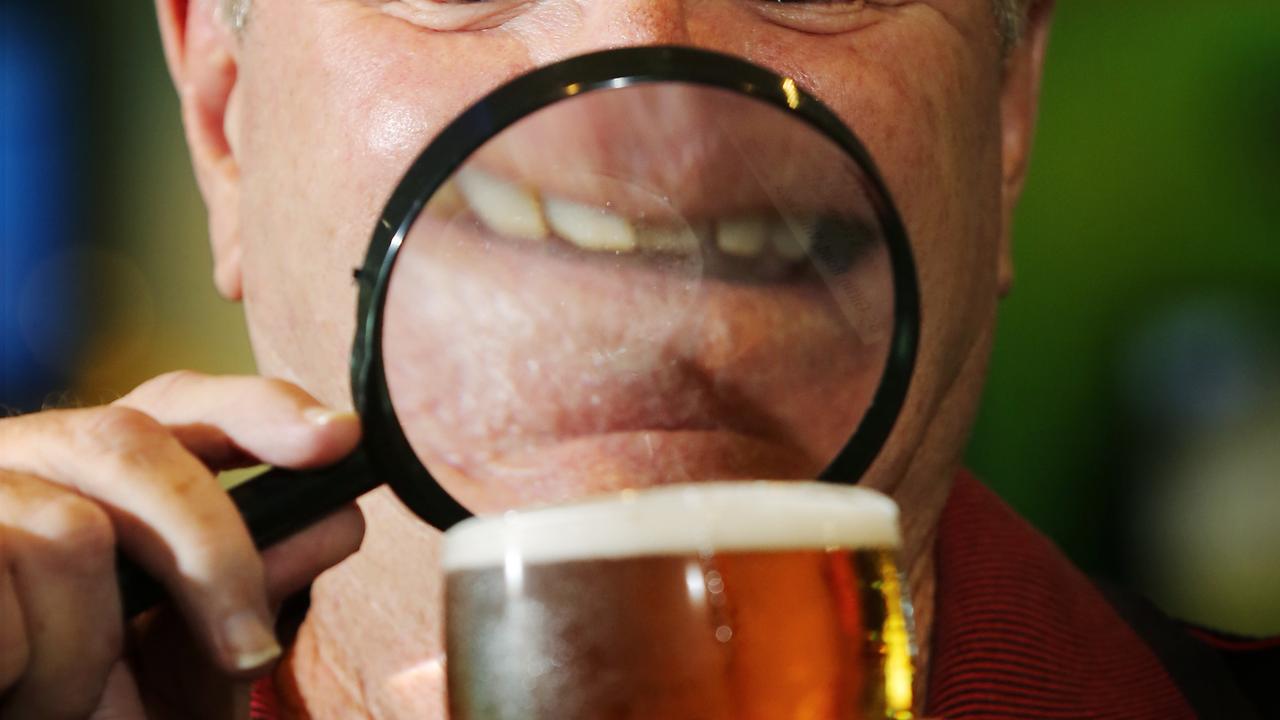Tips to turn torturous ultra-long-range flights into more bearable experiences
Non-stop flights of 16 hours or more cramped in economy class are a special form of torture for many travellers but there are ways to make the experience more bearable.
Business
Don't miss out on the headlines from Business. Followed categories will be added to My News.
For many Australians, taking an eight-hour flight is next to nothing and anything up to 12 hours is generally tolerable, even in an economy class seat.
But with flights of more than 15 and 16 hours becoming commonplace thanks to modern aircraft and the demand for point-to-point travel, the ability to endure sitting upright for the better part of a day is sorely tested.
Qantas has revealed passengers on such ultra-long-range services as Perth-London and Melbourne-Dallas typically watch five hours of in-flight entertainment and presumably try to sleep for a good portion of the remaining journey.
Ahead of its marathon Project Sunrise sprints, Qantas is recruiting economy cabin volunteers for studies into passenger comfort which will monitor sleep, meal service, activity and mood.
Senior content producer at Point Hacks Brandon Loo said the key to such long flights was preparation.
“My non-negotiables include a travel pillow with straps attached so it can attach to the headrest and stop my head lolling about, and a comfortable ‘3D’ padded eye mask,” Mr Loo said.
“I also find melatonin supplements work well in helping me adjust to significant time zone jumps. I can’t usually fall into a deep sleep while sitting upright but having the right set up helps me snooze through a few hours at a time.”

Choice of outfit is also critical because the body typically swells throughout a long flight, making loose or stretchy clothing the best option.
Mr Loo’s go-to is a pair of “easy ankle pants” from Uniqlo which cost under $40 and are “supremely comfortable while still looking presentable”.
“If there’s a transit, then a change of T-shirt and underwear can make a huge difference in feeling fresh on arrival,” he said.
Fellow frequent flyer Adele Eliseo of the Champagne Mile has her own routine for long-haul flights, with a focus on hydration.
With the low humidity of aircraft cabins typically drying out the nasal passages and throat, extra fluid is recommended, and not the amber variety.
“After years of pretending otherwise, I’ve had to accept that indulging in alcohol on-board is the enemy of hydration and sleep,” Ms Eliseo said.
“These days I typically stick to a one or two drink rule. If I’m flying in a premium cabin with a decent wine list, I’ll skip the full glass and ask for tasting pours of the best two or three so I still get the enjoyment without the poor sleep outcomes.”

Ms Eliseo also “pre-loads” with Hydralyte, mixing a couple of sachets before boarding, and ensures her Bose noise-cancelling headphones are stacked with soothing solfeggio frequencies.
Travel Doctor medical director Sonny Lau said the challenges of long-haul flights were many, from the “thinner” oxygen density at high altitudes to the limitations on movement, increased noise and discomfort of low-humidity cabins.
The combination not only leads to dehydration, bloat and headaches, it can increase the risk of deep vein thrombosis and constipation.
Dr Lau said hydration was of utmost importance when flying very long distances, and it tended to have the other benefit of requiring frequent trips to the toilet which means passengers move.
“From a medical perspective we tend to discourage sleeping pills because of the risk of DVT, and for personal security reasons,” he said.
“If you do plan to use sleeping pills, my advice would be to test them out beforehand to understand how they work, and only take them when you’re ready to go to sleep so they don’t wear off.”
If flights of 16 and 17 hours are difficult to endure, particularly in economy, one can only imagine the challenge posed by Qantas’ Project Sunrise services of more than 20 hours.
Due to take off in 2027, the flights will connect Australia’s east coast capitals to cities such as New York, London and Paris in a single hop, using customised A350-1000s.
Of the 238 seats on board, 140 are classed as economy with 84cm between the rows laid out in a 3-3-3 format.
The seat pitch is about 3cm more than Qantas 787-9s currently operating 16-hour plus services such as Perth-London, Perth-Paris and Melbourne-Dallas, and economy passengers will also have access to a “wellness zone” with room to stretch and exercise.
Preparations are still being made for meal services and Qantas is yet to decide if it will stick with the same format used on other ultra-long-haul flights.

In the case of Perth-London, that typically consists of a main meal after takeoff, a mid-flight snack on request and/or access to a snack pantry, and a breakfast-type dish before landing.
Research undertaken in partnership with the Charles Perkins Centre in Sydney has found eating foods with the amino acid tryptophan can help with sleep, and more spicy meals assist with waking up.
Further studies are currently being undertaken focusing on the comfort of economy passengers ahead of the Project Sunrise services.
To that end, economy cabin passengers on Sydney to LA, Johannesburg and New York can volunteer themselves as test cases.
Travellers must be willing to wear a watch that measures sleep and physical activity; a wristband to continuously monitor skin temperature and a sensor to record glucose levels.
They will also be required to fill out a log detailing sleep, meals, exercise and mood.
It’s expected the research will not only help inform Qantas flights, but other airlines operating marathon services.
Mood lighting, cabin temperatures, essential oils and “sleep channels” are just some of the methods already being used in-flight by the likes of United, Emirates, Qatar and Etihad to help lull passengers into slumber.
And if sleep is not possible, there’s always the in-flight entertainment to while away the hours.
“I’ll save up a new-release book or a full season of a bingeworthy TV series that is guaranteed to hold my attention for an extended period of time,” Ms Eliseo said.
More Coverage
Originally published as Tips to turn torturous ultra-long-range flights into more bearable experiences





